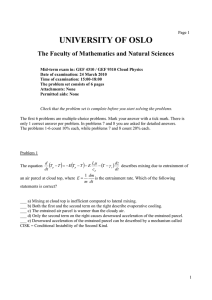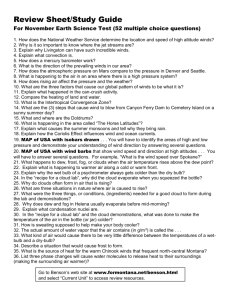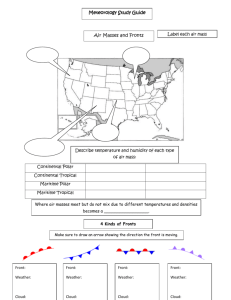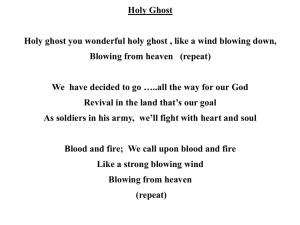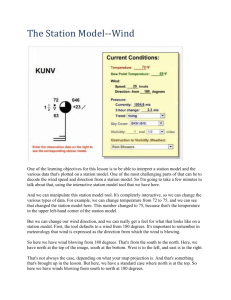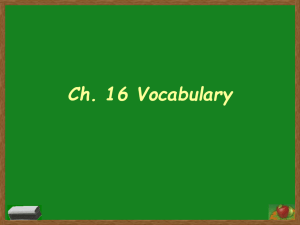21111 Instructor: Prof. Seiberling PHYSICS DEPARTMENT MET 1010
advertisement
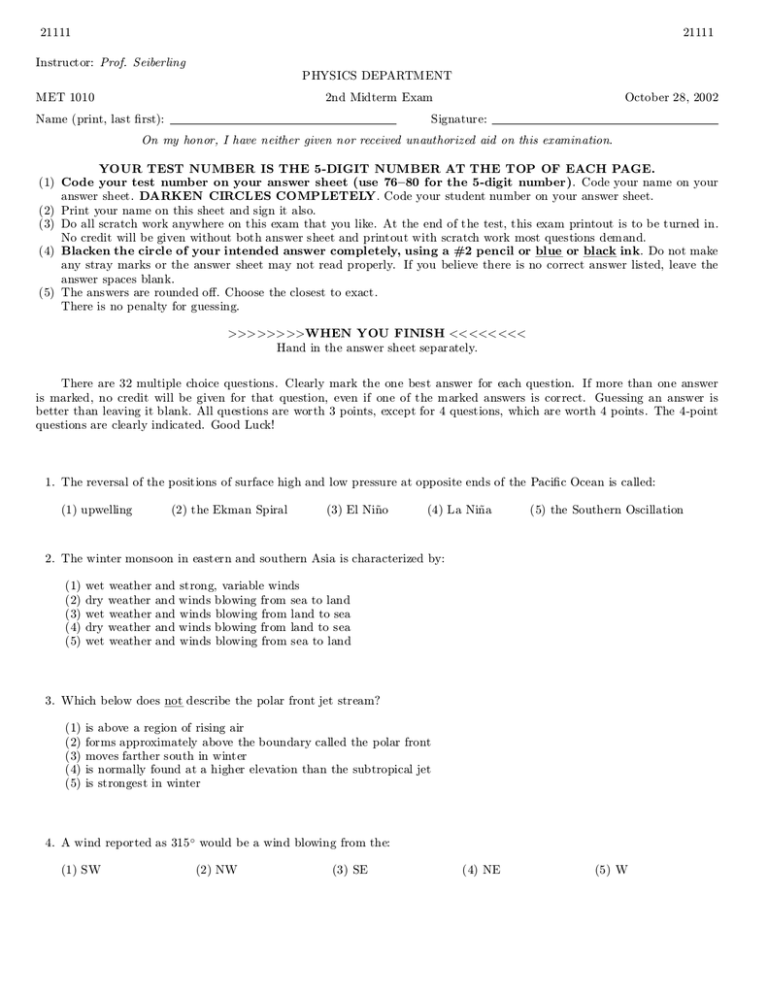
21111
21111
Instructor: Prof. Seiberling
PHYSICS DEPARTMENT
MET 1010
2nd Midterm Exam
Name (print, last ¯rst):
October 28, 2002
Signature:
On my honor, I have neither given nor received unauthorized aid on this examination.
YOUR TEST NUMBER IS THE 5-DIGIT NUMBER AT THE TOP OF EACH PAGE.
(1) Code your test number on your answer sheet (use 76{80 for the 5-digit number). Code your name on your
answer sheet. DARKEN CIRCLES COMPLETELY. Code your student number on your answer sheet.
(2) Print your name on this sheet and sign it also.
(3) Do all scratch work anywhere on this exam that you like. At the end of the test, this exam printout is to be turned in.
No credit will be given without both answer sheet and printout with scratch work most questions demand.
(4) Blacken the circle of your intended answer completely, using a #2 pencil or blue or black ink. Do not make
any stray marks or the answer sheet may not read properly. If you believe there is no correct answer listed, leave the
answer spaces blank.
(5) The answers are rounded o®. Choose the closest to exact.
There is no penalty for guessing.
>>>>>>>>WHEN YOU FINISH <<<<<<<<
Hand in the answer sheet separately.
There are 32 multiple choice questions. Clearly mark the one best answer for each question. If more than one answer
is marked, no credit will be given for that question, even if one of the marked answers is correct. Guessing an answer is
better than leaving it blank. All questions are worth 3 points, except for 4 questions, which are worth 4 points. The 4-point
questions are clearly indicated. Good Luck!
1. The reversal of the positions of surface high and low pressure at opposite ends of the Paci¯c Ocean is called:
(1) upwelling
(2) the Ekman Spiral
(3) El Ni~no
(4) La Ni~
na
(5) the Southern Oscillation
2. The winter monsoon in eastern and southern Asia is characterized by:
(1)
(2)
(3)
(4)
(5)
wet
dry
wet
dry
wet
weather
weather
weather
weather
weather
and strong, variable winds
and winds blowing from sea to land
and winds blowing from land to sea
and winds blowing from land to sea
and winds blowing from sea to land
3. Which below does not describe the polar front jet stream?
(1)
(2)
(3)
(4)
(5)
is above a region of rising air
forms approximately above the boundary called the polar front
moves farther south in winter
is normally found at a higher elevation than the subtropical jet
is strongest in winter
4. A wind reported as 315 ± would be a wind blowing from the:
(1) SW
(2) NW
(3) SE
(4) NE
(5) W
21111
21111
5. Chicago, Illinois (latitude 42 ± N) is located in the
(1) westerlies
(2) southeast trades
.
(3) northeast trades
(4) horse latitudes
(5) doldrums
6. The wind's speed generally increases with height above the earth's surface because:
(1)
(2)
(3)
(4)
(5)
air parcels expand and become less dense as they rise above the surface
wind instruments are not accurate at the earth's surface
only the highest layer of air rotates with the earth
friction with the earth's surface slows the air near the ground
air temperature normally decreases with height
7. (4 pts) I have a parcel of air at some pressure, P, temperature, T and volume, V. If I increase the temperature from 20± C
to 40 ± C, while keeping the pressure constant, what happens to the volume? (Hint: add 273 to temperature in ± C to get
temperature in K)
(1) V increases by 50% (2) V remains constant (3) V decreases by less than 10% (4) V doubles (5) V increases by 50%
8. For a golf-ball sized hailstone to develop, it must remain in the cloud for about:
(1) 6 hours
(2) 1 hour
(3) 10 minute
(4) 24 hours
(5) 1 minutes
9. (4 pts) What is the dew point inside the cloud at 2000 m?
(1) 9 ± C
(2) 8 ± C
(3) 10 ± C
(4) 11 ± C
(5) 12 ± C
10. Radar gathers information about precipitation in clouds by measuring the:
(1)
(2)
(3)
(4)
(5)
amount of sunlight scattered o® the precipitation
energy emitted by the precipitation particles
amount of solar energy passing through the cloud
absorption characteristics of falling precipitation
amount of energy re°ected back to a transmitter
11. A pressure plate anemometer determines
(1)
(2)
(3)
(4)
(5)
by measuring the
.
wind speed, angular de°ection of a plate
wind speed, deformation of a membrane
air pressure, deformation of a membrane
wind direction, angular orientation of a plate
altitude, deformation of a membrane
12. During the summer in humid climates, nighttime clouds tend to form over water during a:
(1) monsoon
(2) sea breeze
(3) land breeze
(4) chinook wind
(5) Santa Ana wind
21111
21111
13. Why are clouds generally con¯ned to the troposphere?
(1)
(2)
(3)
(4)
(5)
gravity is too weak above the tropopause
there is an inversion in the stratosphere
ozone in the stratosphere charges the cloud droplets
mountains don't extend up into the stratosphere
clouds are not usually con¯ned to the troposphere
14. During the summer, ocean water is colder near the northern California coast than it is further north along the coast near
Seattle mainly because of:
(1) oceanic fronts
(2) upwelling
(3) evaporation
(4) the California current
(5) cold air moving over the water
15. The average winds aloft are strongest in:
(1) wind speeds aloft do not vary with season
(2) winter
(3) spring
(4) summer
(5) fall
16. In a certain area, the surface temperature and dew point are 28 ± C and 18 ± C, respectively. The environmental lapse rate is
12± C from the surface up to 1000m, then is 8± C for the next 1000m, then is 4± C from 2000m upward. (The dry adiabatic
rate is 10 ± C/1000m, the moist adiabatic rate is 6 ± C/1000m and the dew point drops by 2 ± C/1000m.) Use these data to
answer the following four questions. What is the overall stability of this atmosphere from the surface up to 3000m?
(1) neutrally stable (2) conditionally unstable (3) absolutely unstable (4) absolutely stable (5) conditionally stable
17. Which of the forces below can never change the speed of a wind?
(1)
(2)
(3)
(4)
(5)
centripetal and pressure gradient
friction and pressure gradient
centripetal and Coriolis
pressure gradient and Coriolis
Coriolis only
18. Which type of precipitation would most likely form if snow falls through an above-freezing layer, then enters a shallow
freezing layer near the ground?
(1) hail
(2) freezing rain
(3) snow
(4) drizzle
(5) rain
19. A small crystal of pure ice and a small droplet of pure water are both suspended in a cloud maintained at a temperature
of ¡10 ± C. What is likely to happen?
(1)
(2)
(3)
(4)
(5)
both the ice crystal and the water droplet will grow by accretion
the ice will grow and the water droplet will shrink
neither the ice crystal nor the water droplet will change size
the water droplet will freeze and the ice crystal will not change
the water droplet will grow and the ice crystal will shrink
20. Which of the following might be mistaken for hail?
(1) dendrite
(2) supercooled droplet
(3) ice nuclei
(4) graupel
(5) virga
21111
21111
21. A knowledge of air stability is important because:
(1)
(2)
(3)
(4)
(5)
it
it
it
it
it
determines how much moisture is in the air
determines the vertical motion of air
determines seasonal weather patterns
determines the direction of movement of storms
determines the movement of high pressure areas
22. In the Northern Hemisphere, ocean currents in the Atlantic and the Paci¯c move in a generally circular pattern. The
direction of this motion is
in the Atlantic and
in the Paci¯c.
(1)
(2)
(3)
(4)
(5)
counterclockwise, counterclockwise
neither; the direction of the ocean currents depends on the season
counterclockwise, clockwise
clockwise, counterclockwise
clockwise, clockwise
23. If in the Northern Hemisphere the clouds high above you are blowing from south to north, then it is a good bet that an
upper-level trough of low pressure is to the
of you.
(1) south
(2) west
(3) east
(4) north
(5) right above
24. The world's deserts are found at about 30± latitude because:
(1)
(2)
(3)
(4)
(5)
of the sinking air of the subtropical highs
of the convergence of the prevailing westerlies and the Northeast Trades
the intertropical convergence zone is located there
of the sinking air of the polar front
of the doldrums
25. (4 pts) The net force acting on air which is blowing parallel to straight contours at constant speed is:
(1)
(2)
(3)
(4)
(5)
in the direction of wind motion
in a direction opposite the wind's motion
in the direction of the pressure gradient
to the right of the wind's motion in the Northern Hemisphere
zero
26. A strong wind is blowing past an obstacle. On the downwind (leeward) side of the obstacle, the wind is likely to be:
(1)
(2)
(3)
(4)
(5)
reduced to zero
reversed from the original direction
much the same as on the upwind side
lighter and more steady
strong and steady
27. The name commonly used to describe the drier region observed on the downwind (leeward) side of a mountain range is:
(1) inversion region
(2) dryline
(3) orographic
(4) compression region
(5) rain shadow
21111
21111
28. At what height above the surface of the earth would a convective cloud base form?
(1) 1250 m
(2) 1000 m
(3) 1500 m
(4) 2000 m
(5) 1750 m
29. One day, the 500 mb surface above your city was at 5620 m. A week later, the 500 mb surface above the same city was
at 5740 m. What most likely happened in your city during that week?
(1)
(2)
(3)
(4)
(5)
a cold front passed through
the temperature increased
a full moon occured
the winds aloft became geostrophic
the atmosphere became more unstable
30. What supports the weight of the column of mercury in a mercury barometer (so that the mercury does not °ow out of
the column)?
(1)
(2)
(3)
(4)
(5)
surface tension
the mercury in the dish below the column
capillary action
the gravitational force on the mercury
the pressure of the atmosphere
31. Large raindrops fall
than smaller raindrops, and have a
terminal velocity than small raindrops.
(1) faster, smaller (2) slower, smaller (3) slower, larger (4) faster, larger (5) the speed of raindrops is independent of size
32. (4 pts) What is the temperature inside the cloud at 2000 m?
(1) 11 ± C
(2) 8± C
(3) 10± C
(4) 12 ± C
(5) 9 ± C
